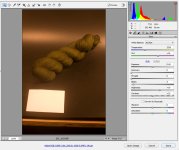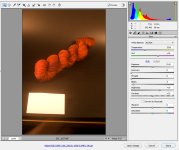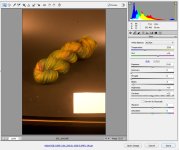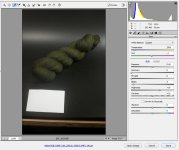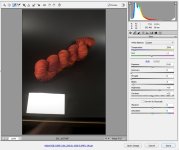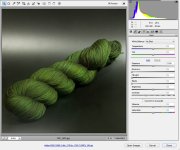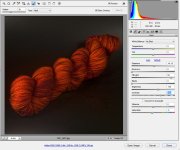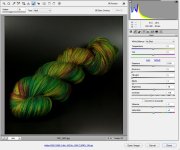You have been an eye opener. I'm very grateful for all this help. I didn't know much about raw, and I'm beginning to learn how much I don't know. I like it that all of the original data collected by the camera is retained even after editing. I really like it that it's a tool that I already have on my machine. The bulk editing features seem amazing, and they are the basis of this question. In the images you edited simultaneously, your subject was not only sitting in the same lighting, but she was wearing the same color. Could you bulk edit as successfully if she were wearing different clothes in each image, or if different people were sitting in otherwise identical conditions? In our situation, we're photographing yarn which, while infinitely more patient than human subjects, are created in an infinitely wider variety of color. Is the bulk edit feature of raw likely to work for me, or are we better off by just editing the several views of each yarn together, but separate from any other colors in the queue to be corrected as you say?
If the goal is correct color, as opposed to tweaking to enhance colors, then no, it does not matter what color clothes or which people are sitting there. The WB goal is to make a white card actually come out white (don't position it so other colors can reflect onto the card - just the direct light only). When achieved, and the card is accurate, then all other colors will be shown as they are too, also accurate. You will have matched WB to the actual lights color.
Now, there are people that don't quite like neutral color, and prefer their portraits to be a little warm perhaps. But after correcting it, you can then slightly offset the WB a bit, to look as you prefer it (from this known base). Or not. To me, the goal is correct color.
Yes, if you don't change the lighting as you go, I think correcting the WB of the yarn will work fine. I think it is the only chance.

OK, more crude tries (using only camera WB settings) can get halfway close, just never quite precise.
But if seeking most accurate color, I would not use fluorescent lighting, which may or may not be OK, but that is another issue. Incandescent, flash, or sunlight are fine. Don't mix them however, use one type of light source.
Note that exposure also can change shades of color. Overexposure reproduces the shade lighter, and underexposure makes it darker. You can adjust that in the Raw editor. And if you are printing it, that is another issue. And if shown on the internet, of course, you have no control about the calibration of a customers web monitor. Color is not the easiest thing.

But accurate WB will at least let it start out right.
If using Adobe software, be sure your final JPG output uses sRGB profile, and NOT the Adobe RGB profile. The internet and and the photo printing places use sRGB.
After I asked about making a white card, I read what you said about brighteners that actually lean blue. Sensible about the copy paper alternative, but I'll try a Portabrace, $5.21 & free shipping at Amazon, but it's part of their Add-On line of low priced items that wouldn't otherwise be practical to ship, and you have to place a minimum order of $25, I think. I order from them weekly, so I just added it to my list.
When I open an image (jpeg) in camera raw, the white balance drop-down displays only 3 options: As Shot, Auto, & Custom. What do I do to get the other options I see in your video?
Is it Adobe Raw software? It sounds like you are using a JPG file instead of a Raw file. That's what they do.
Adobe Raw offers lossless editing of JPG too, however JPGs are already JPG, and they already have WB in them, so you cannot now choose original WB. It has been done. You can tweak it now. So now you see a + / - type of adjustment for JPG.
Whereas Raw files will show the normal WB menu, Daylight, incandescent, etc. They have no WB in them yet.
Lossless editing:
Adobe Raw does lossless edit on JPG too, but you need to know what that means. You edit it and change stuff, WB and color and contrast and exposure and crop it, and whatever. The original JPG data is NOT affected. Original file is always preserved. It saves a list of your edits (somewhere else in that JPG file), and when you output ANOTHER JPG, then it applies those changes to the original data, and you get a new corrected JPG. Data is shifted only that one time (plus the JPG the camera made).
If you show that original JPG file in other programs, they only see the original. You will see NO CHANGES. They don't know about this list of edits. You have to output another JPG for other uses, which will include your edits. NEVER EVER overwrite your original file, ever. But... no matter how often you go back in there and shift the edits around more, you are NOT shifting the original data back and forth. If you make more changes, you only change the list, not the data. You shift the original data only ONE TIME when you output the new JPG. Then, if you discover you want additional changes, you discard that last JPG (expendable), and go back to your lossless original master, change the change list, and output a new JPG, which is shifted only that one time. Never any shifting data back and forth, which can be destructive.
This list will be invisible to you, but it is how it works, and these settings will already be made in the raw tools. You can always reset them off, and have your original again. Raw files work that way too, lossless edits. It means the original data is always preserved. The output is shifted only one time.
ETA: I forgot to ask about something you wrote in your last post.
How do you mean shifting?
To change WB or exposure or contrast or anything affects tonal values. Changing tonal values is a shifting the RGB channels lower or higher (in the histogram). The way you change the color of anything involves shifting it in the histogram, from one value to another value.
For example, look again at
White Balance Correction, with or without Raw
at the very bottom image there, at bottom of page. It is an animation showing white balance shifting channels, in this example, from incandescent to flash WB. Watch the RGB histogram channels shift. Red shifts one way, blue shifts the other. This is what WB does.
This is a very drastic change or shift. Not much else gets that drastic. WB is done in the camera to be JPG, while the data is still 12 bits. Or it is done after uploading Raw data into the computer, while still 12 bits. Raw has several important virtues, and this is one more. However, this much shift would be very hard on 8 bit JPG data, just couldn't do that extreme. Mild shifts work better on 8 bit JPG data.
But JPG already has the WB done on it, not necessarily precise, but milder adjustment is all JPG ought to need.
I'm going fast, I hope it makes sense.

